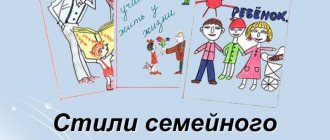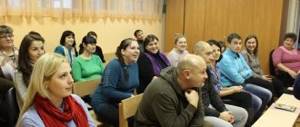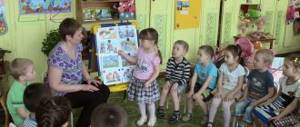Methods for studying the characteristics of family education.
Since the interaction between family and preschool education plays an important role in the development of the child and ensuring the continuity of preschool and school education, a detailed study of the family is necessary.
In recent years, attention to the study of the family as an educational institution has increased from pedagogy, psychology, sociology and other sciences. However, the possibilities of scientists in research are limited due to the fact that the family is a rather closed unit of society, reluctant to initiate outsiders into all the secrets of life, relationships, and values that it professes.
Methods for studying the family are tools with the help of which data characterizing the family is collected, analyzed, and generalized, and many relationships and patterns of home education are revealed.
The creation of a unified educational space, including teachers and parents as its equal components, is possible provided that the characteristics of each specific family are taken into account. However, the family is a rather closed educational institution, reluctant to reveal to an outside observer the features of its life activities and relationships. She never opens up to other people completely, but only as much as it can create a positive image of her.
The teacher conducting the research must obtain the consent of the family. Then, when planning and carrying out such a study, it is necessary to solve the problem: how, on the one hand, to take into account the uniqueness of each family - the general cultural and educational levels of its members, moral and psychological attitudes, life experience, and on the other hand, not to violate the fragile boundaries of intrusion into the family, legally defined by a person’s right to privacy.
In solving this complex problem, the teacher can be helped by a family study plan, which allows for family research to be carried out consistently, systematically, while spending a minimum of time and limiting the entire amount of information received about the family to the part that is necessary for planning, organizing and conducting various forms of work with parents.
Drawing up a plan can occur gradually as information about the family accumulates. However, it should not become a form filled out once and for all. It needs to promptly reflect any changes in the life of the family. The implementation of the family study plan occurs using various methods that allow collecting, analyzing, and summarizing data characterizing the family, and exploring many relationships and patterns of home education.
The choice of methods for studying the family and the experience of family education depends on two important circumstances. The first of them is the individuality, uniqueness, uniqueness of each family. There are noticeable differences in families, which manifest themselves:
– in the educational and cultural levels of all its members;
– moral and psychological attitudes and positions;
– life experience;
– aspirations, models and ideals;
– skills and abilities to organize the life activities of parents and children;
– experience in raising children.
The second circumstance: the family is a fairly closed cell (micro-collective) of society. Therefore, the capabilities of scientists (teachers, psychologists, social educators, sociologists, etc.) in studying family problems and the experience of family education are very limited. And yet, methods for studying these problems are being developed and applied.
The study of the family must be carried out consistently, systematically, therefore it is necessary to outline areas of work, a kind of plan.
As an approximate plan, I offer you a plan drawn up taking into account the recommendations of scientists (V.V. Kotyrlo and S.A. Ladyvir):
1. Family composition, professions, educational level of parents, other adult family members taking part in raising the child.
2. General family atmosphere, features of relationships between family members:
- friendly tone of communication towards each other;
- changeable, contradictory nature of relationships;
- a kind of autonomy of each member in the family.
3. The purpose of raising a child at home.
4. The degree to which parents are aware of the special role of the preschool period of childhood in the formation of the child’s personality.
5. Family priorities in raising a child: health, development of moral qualities, mental, artistic abilities, early education of the child.
6. Level of psychological and pedagogical knowledge, practical skills of parents:
— presence of certain knowledge and readiness to replenish and deepen it;
— limited knowledge and pliability to pedagogical education;
- low level of knowledge and negative attitude towards its acquisition.
7. Features of educational influences:
— participation of all adults in education, degree of coordination of educational activities;
- inconsistency, inconsistency of upbringing, the presence of conflicts regarding upbringing; a family member who primarily performs an educational function;
- lack of upbringing as a targeted influence, conditions for the full development of the child.
8. Organization of modern forms of activity in the family:
- community in all family affairs, involvement of the child in family affairs, concerns;
- differentiation of responsibilities among adults, occasional involvement of the child in family affairs;
- disunity of adults in family matters, isolation of the child from family affairs and concerns.
9. The family’s attitude towards the preschool institution:
— highly appreciate the educational opportunities of the kindergarten and are ready to cooperate;
— they are wary and distrustful of kindergarten and do not see the need for cooperation;
— they shift all educational functions to the kindergarten and are not ready to cooperate;
- They are indifferent to kindergarten and to raising their own child.
Thus, I study the family, the experience of family education, pursuing primarily the interests of the child. Based on the materials obtained, it is possible to solve the problems of complementary family and preschool education, increasing the effectiveness of both.
Traditional and non-traditional methods of studying family
Studying a family requires the use of a combination of methods - observation, experiment, tests, surveys, conversations. The main research methods in pedagogy and psychology include observation and experiment. Scientific methods of studying families are also methods of practical interaction with parents.
When studying families, the most common method is observation.
Observation is a purposeful, specially organized and recorded perception of the object under study.
Organizing family monitoring requires mandatory planning, which includes the following steps.
1. Determining the purpose and objectives of observation, for example, achieving the goal of studying the characteristics of communication between an adult and a child can occur through the implementation of the tasks of studying the emotional attitude of an adult to a child, assessment activities, requirements, questions for children. In turn, each of these tasks for a certain period of time can become an independent goal, the achievement of which will require the establishment of intermediate tasks. For example, studying the evaluative attitude of an adult towards a child will require research into systematicity, differentiation, objectivity, motivation and much more in parents’ assessment of their child.
2. Selection of object, subject and situation of observation. The child and parents, their personal qualities and relationship characteristics can be observed in kindergarten (during the child’s activities or play with peers, parents’ interaction with the child in the morning and evening) and when visiting the family. In the informal atmosphere of holidays, entertainment, excursions, trips, children and parents can observe their new features that were not available before.
3. Choosing an observation method that has the least impact on the object under study and most ensures the collection of the necessary information. This method is used by the so-called “participant observation”, which allows you to see those features of family life and relationships in it that are often hidden during external observation or observation from the outside. Participant observation is made possible by situations of joint work and leisure between parents and children that are specially created by the teacher.
4. The choice of methods for recording what is observed, for example, a detailed recording of actions and words with their subsequent analysis is not always acceptable for a number of reasons. Firstly, the observer is simply not able to record everything that is happening and involuntarily highlights those elements that he subjectively considers the most important and ignores others. Secondly, recording what is happening eliminates the main advantage of observation - the subject’s ignorance of the fact that he is being observed. Using a tape recorder, voice recorder or video camera for recording overcomes the first disadvantage of handwritten notes, i.e. the technology impartially records everything, and such records can be accessed many times. But the second drawback - the unnaturalness of the manifestations of the observed object in the event of detection of observation - remains. The solution may be to organize observation by several teachers, keep independent records and then compare them, as well as develop parameters of observed behavior and methods for recording them.
5. Processing and interpretation of the information received can be quantitative or qualitative in nature. Quantitative processing is the counting of facts recorded during observation. For example, you can count how often a parent addresses a child by name. Qualitative processing can consist either in identifying the relationship between observed facts, presenting them in the form of some kind of structure, or in identifying phases (stages) in the development of the observed phenomenon.
Interpretation is the assignment by the researcher of a certain meaning to the data obtained. If we return to the definition of observation as an organized perception of the object being studied, then clearly not only an activity, but also its product can act as this object. of analyzing the products of activity as a type of observation becomes understandable
In the process of analyzing the products of activity, the researcher deals not with the child himself, but with the plot of the game, the construction of blocks, a drawing, a story. At the same time, he analyzes the process of making the product of this activity (game, constructive, visual, speech) and thanks to this, discovers the personality characteristics and interpersonal relationships of the subject. Considering that play is the leading activity of a preschooler, games with a family plot can provide a lot of information about the family for an observant teacher.
The second main research method is experiment.
An experiment is the active intervention of a researcher in the activities of a subject in order to create conditions in which a fact is revealed.
Unlike observation, it is difficult to organize it so that the person being studied does not know about it. The experiment requires relatively complete control of the experimenter, which means “transparency” of family life, the need for its members to control themselves all the time. Consequently, organizing an experiment within a family can lead to disruption of its natural life activity and the relationships that have developed within it for quite a long time. Therefore, the use of this method in the study of families is limited. An experiment can be organized in the case when the research work carried out by the preschool educational institution requires support and assistance from parents and its continuation in a family environment, but the experimental work should not run counter to its interests.
Auxiliary research methods in psychology and pedagogy include: test, conversation, survey, etc.
A test is a short, standardized, usually time-limited test, during which the subject performs certain actions on the instructions of the researcher: answers questions (test-questionnaire) or solves a practical problem (test-task). In our country, to determine how a child is raised in a family, psychologists in most cases use the three most well-known tests: “Parental Attitude Questionnaire Test” (PRO) by A.Ya. Vargi, V.V. Stolin; “Analysis of Family Relationships” (AFR) E.G. Eidemiller, V. Justitskis; Transitional Questionnaire “Measurement of Parental Attitudes and Reactions” (PARY) by E. Schaefer. These tests are used both separately and in combination, since they complement each other.
There are projective tests that are more informative than conventional tests due to greater freedom in the interpretation of the former. But obtaining accurate and deep information about the family with their help is possible only by qualified psychologists. Data obtained using projective techniques must necessarily be clarified by other methods.
A survey is a method in which a person answers a series of questions asked to him. The survey can be anonymous and personalized. Data obtained from an anonymous respondent tends to be more sincere. But since the goal of studying the family by preschool teachers is the possibility of using the information obtained in the future to individualize work with parents, it is preferable to conduct personalized surveys, although the answers to the questions may not be entirely truthful. For example, parents who frequently physically punish their children are unlikely to select the appropriate answer on a questionnaire; they are more likely to emphasize the answer “we never resort to physical punishment” or settle on the answer “we sometimes resort to physical punishment.”
A questionnaire is a written survey, usually devoted to a specific topic. The reliability of the questionnaire data is checked in two ways: 1) by repeating the survey of the same persons using the same procedure, which helps to check the stability of the information; 2) control of this data by other methods.
A conversation is a method of directly or indirectly identifying information about his activities and mental properties of a person in live two-way communication with a subject.
There are certain requirements for conversation as a method of study.
1. The conversation should be casual. It cannot be turned into a survey, i.e. to receive answers to questions asked.
2. During the conversation, personal contact must be established between the researcher and the subject. This is not necessary to conduct the survey.
3. A conversation involves, along with answers, asking questions to the subject, which a survey does not allow, i.e. the conversation is two-way in nature, which provides more information on the problem under study.
Interviewing (English, interview - conversation, meeting) is a method of obtaining information through an oral survey, in which the interviewer comes into contact with the respondent. There are usually two types of interviews: free, which is not regulated by the topic and form of the conversation, and standardized, which is close to a questionnaire with closed questions. The answers of respondents (children, parents) are recorded by the interviewer or his assistant (assistant) or mechanically (on tape, tape recorder, voice recorder).
Basic requirements for conducting an interview:
1. Choosing the right place for the interview and creating a favorable atmosphere for communication so that there are no obstacles during its conduct.
2. Before the interview begins, a brief word from the interviewer is required, which clearly states the purpose and objectives, and guarantees the anonymity of the survey.
3. Maintaining a neutral position of the interviewer, implying complete non-interference in the content of the survey.
4. Organization of correct recording (verbatim recording, short recording, recording from memory, recording on a tape recorder, voice recorder).
Psychological and pedagogical training is a method that helps to simultaneously study and correct the pedagogical position of parents. Parents are offered tasks, by completing which they develop certain skills, adjust their views and positions, and participate in reflective activities. Training topics: “How to behave with an aggressive child”, “How to behave with a hyperactive child”, “If a child is developmentally delayed”, “How to raise a child without a father”, “Features of raising an adopted child”, “Specifics of raising a family of many children”, “Features of raising an only child”, “How to raise twins”, etc.
A child’s performance of a certain practical task in the presence of his mother, father, grandmother, and grandfather is a method that allows one to draw a conclusion about the characteristics of family upbringing. The teacher (educator) creates a situation: before the mother (father) arrives, the son is invited to disassemble the parts from the construction set and put them in a box. The teacher (educator) observes the reaction of the mother (father) to the son’s completion of the task, the nature of their help, methods of stimulating or suppressing children’s independence, assessment of the quality of work, etc. Here the teacher (educator) can notice two options for the behavior of the mother (father): first - mother (father) quickly helps her son put the parts into the box; the second - the mother (father) only encourages his son, praises him for his dexterity and speed of operations, but does not herself (himself) help him complete the task. In the first case, the teacher confirms his hypothesis about the presence of laziness in the boy, in the second - about the presence of hard work, conscientiousness, and diligence.
A method for parents (father, mother) to write a mini-essay “My Child.” By studying these essays, the teacher can see the child’s character traits, his interests, abilities, favorite activities, positive and negative aspects of his development in a family environment. By comparing parents' data about children and the data of their observations, the teacher can more accurately and objectively create an independent characteristic of the pupil, methods and techniques of education.
The drawing technique is a technique aimed at studying the child’s ideas about the family, parents, his position in the family, and the relationships of family members. The child is asked to draw his family. Without imposing anything, they say: “Draw the way you want.” When the drawing is finished, you can clarify some details about the family members.
The teacher pays attention to the following details:
1) how family members are located;
2) how far they are from each other;
3) what is the location of the child himself among all family members;
4) with whom the child began drawing the family, and with whom he finished;
5) who is taller and who is shorter;
6) who is large in size and who is small;
7) who is painted in what colors.
What can you learn when decoding a picture?
1. The absence of family members in the picture is an acknowledgment of the child’s discomfort in the family.
2. The absence of the artist himself in the drawing is a signal of conflict between him and family members.
3. The presence of only the artist himself in the drawing is a signal of loneliness, a sign of family trouble, discomfort.
4. The presence of some stranger in the picture is a sign that the child dreams of improving family relationships.
5. A child’s image of himself, as tall as his mother or father, is a sign of his comfort in the family.
6. The close proximity of family members to each other is an indicator of love and care in family relationships.
Parents and teachers, having become acquainted with children’s drawings, will be able to find the answer to such exciting questions: “How to recognize what worries a child?”, “How do children perceive us and our relationships?”, “How do we see ourselves and our children?”, “How to identify hidden conflict in the family?” and etc.
Psychogram of marriage and its features
Modern methods of studying families are based on the use of various psychograms, which make it possible, using a series of simple questions, to determine the level of compatibility of two people or their pedagogical preparedness for raising a child. The list below presents the main methods for conducting such psychograms, which will allow you to understand relationships in as much detail as possible. Family study methods include the following elements:
- Authoritarian socialization is a reflection of control over the child and the form of upbringing. With a high score of this element, a parent can be confident that his child will be able to adapt to society in a few years. But with a low score, problems with upbringing are quite often observed. Some parents may punish their children for any manifestation of independence, and also scold them for their thoughts, feelings and individual abilities.
- "Little Loser" system. It is a reflection of parenting methods and the child’s perception of parents. The point of this method is that the child must be fully aware that his own desires and ambitions are much lower than the instructions of his parents. If this test shows a high result, then you should seriously think about changing the methods of raising your child, otherwise this will lead to the child completely ignoring his parents.
- Rene Gilles' technique, based on a study of the personality of the child and his parents. Various pictures are used as study material to help identify certain character traits of a person. In addition, this technique involves passing a special test that reveals a person’s potential behavior in a given situation. The test tasks have from three to five answer options, so even a primary school student will not have much difficulty passing it.
- “Cooperation” is the desire and ability of parents to engage in joint activities with their child. The study is carried out using various individual tasks that the family psychotherapist gives to his patients. If the specialist notices that the child is very reluctant to complete the task with his parent, then there will be a need to find the root of the problem. This technique also includes passing joint testing, the results of which indicate how well the child gets along with his parents.
- “Symbiosis” is a scale reflecting the interpersonal distance between the objects of study. High testing rates indicate that the parent is not only trying to make contact with his child, but also to establish a trusting relationship with him. In such families, there are no secrets between parents and children from each other, which leads to mutual understanding and respect even in the most difficult life situations.
Mastering family study methods (we briefly discussed the main ones above) is not that difficult.





